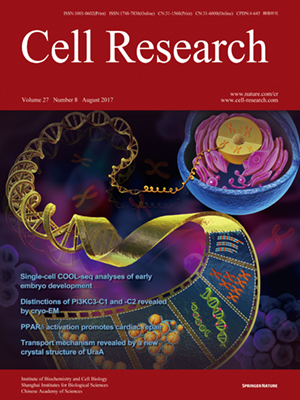
Volume 27, No 8, Aug 2017
ISSN: 1001-0602
EISSN: 1748-7838 2018
impact factor 17.848*
(Clarivate Analytics, 2019)
Volume 27 Issue 8, August 2017: 1020-1033 | Open Access
ORIGINAL ARTICLES
Dimeric structure of the uracil:proton symporter UraA provides mechanistic insights into the SLC4/23/26 transporters
Xinzhe Yu1,2,*, Guanghui Yang1,2,*, Chuangye Yan1,2, Javier L Baylon3, Jing Jiang1, He Fan1, Guifeng Lu1, Kazuya Hasegawa4, Hideo Okumura4, Tingliang Wang2, Emad Tajkhorshid3, Shuo Li5 and Nieng Yan1,2,3
1State Key Laboratory of Membrane Biology, School of Life Sciences and School of Medicine, Tsinghua University, Beijing 100084, China
2Beijing Advanced Innovation Center for Structural Biology, Tsinghua-Peking Joint Center for Life Sciences, School of Life Sciences and School of Medicine, Tsinghua University, Beijing 100084, China
3Center for Biophysics and Quantitative Biology, Beckman Institute for Advanced Science and Technology, Department of Biochemistry, University of Illinois at Urbana-Champaign, Urbana, IL 61801, USA
4Protein Crystal Analysis Division, Japan Synchrotron Radiation Research Institute, 1-1-1 Kouto, Sayo-cho, Sayo-gun, Hyogo 679-5198, Japan
5College of Life Sciences, Sichuan University, Chengdu, Sichuan 610064, China
Correspondence: Nieng Yan, E-mail: nyan@tsinghua.edu.cn; Guanghui Yang,(ygh12@mails.tsinghua.edu.cn)
The Escherichia coli uracil:proton symporter UraA is a prototypical member of the nucleobase/ascorbate transporter (NAT) or nucleobase/cation symporter 2 (NCS2) family, which corresponds to the human solute carrier family SLC23. UraA consists of 14 transmembrane segments (TMs) that are organized into two distinct domains, the core domain and the gate domain, a structural fold that is also shared by the SLC4 and SLC26 transporters. Here we present the crystal structure of UraA bound to uracil in an occluded state at 2.5 Å resolution. Structural comparison with the previously reported inward-open UraA reveals pronounced relative motions between the core domain and the gate domain as well as intra-domain rearrangement of the gate domain. The occluded UraA forms a dimer in the structure wherein the gate domains are sandwiched by two core domains. In vitro and in vivo biochemical characterizations show that UraA is at equilibrium between dimer and monomer in all tested detergent micelles, while dimer formation is necessary for the transport activity. Structural comparison between the dimeric UraA and the recently reported inward-facing dimeric UapA provides important insight into the transport mechanism of SLC23 transporters.
10.1038/cr.2017.83
FULL TEXT | PDF
Browse 1925


